YANGSHUO, CHINA - My “Huckleberry Fung” adventure starts when I board a small bamboo raft on the banks of the Little Li River in this southeast China outpost. “Fung” is the tall slender man piloting the precarious-looking craft that’s tied together with simple bailing wire. But my Chinese Tom Sawyer assures me the raft is seaworthy before he pushes off from the muddy shore with the aid of a long bamboo pole.
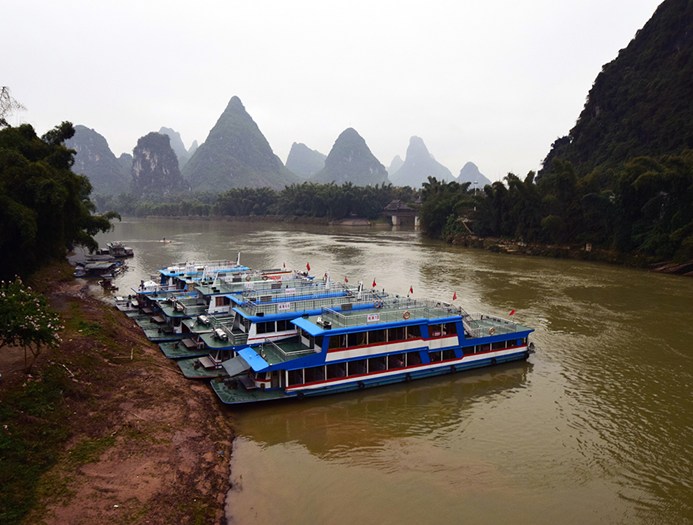
Above: The lovely mountain setting that surrounds Yangshuo.
As we slowly float down the tributary to the much larger Li River, we find ourselves surrounded by many more bamboo rafts filled with domestic tourists who have come to view the area’s breathtaking karst mountain topography.
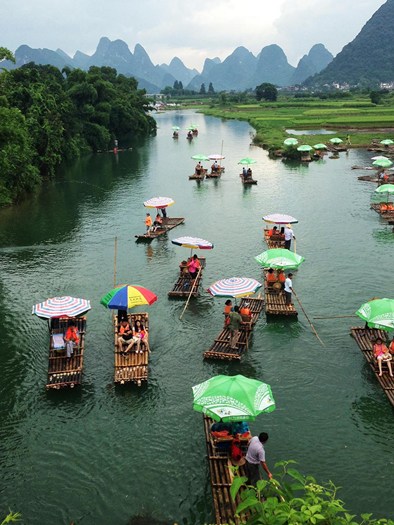
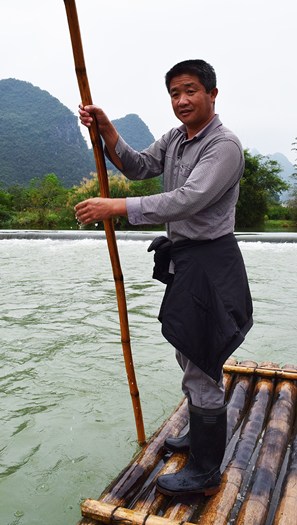
Left: The rafts are canopied with some coloruful umbrellas. Right: The guide Mr. Fung..
The humped-back-shaped mountains rise majestically along the shore and stand silhouetted against a grey sky, making them look even more imposing and magical from my watery vantage point.
Fung tells me the limestone mountains are slowly dissolving and in “100 million years they will be as flat as a field — so you better tell people to come and see them soon,” he laughs.
The decaying mountains have honeycomb interiors and feature many sinkholes and caves that visitors can explore. In fact, this area attracts a lot of foreign adventures, many of who have stayed on in Yangshuo, where they’ve opened restaurants and bars.
“There are more than 3,000 caves in Guilin (Yangshuo is one of the many districts that make up Guilin) and seven caves in Yangshuo are open to explore,” says Fung.
The stalagmite-filled caves have been bathed in artificial light to enhance the experience and the tallest of the area’s karst formations — at 870 metres — is Yao Mountain.
“No, we did not name the mountain after our great basketball star Yao Ming,” smiles Fung, referring to China’s former NBA legend.
Life has changed little in Yangshuo over the ages; women still pound their dirty laundry on rocks along the shores of the Little Li River, and fishermen wade into the shallow water to set their nets, much like their ancestors.
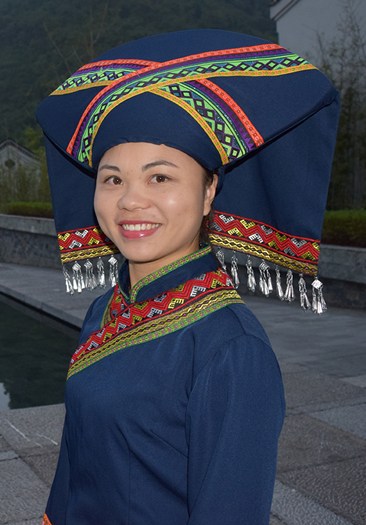
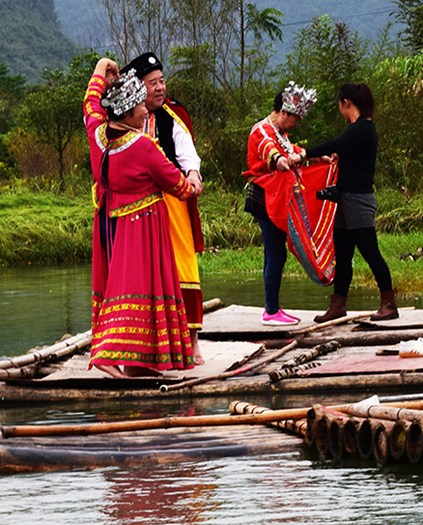
Above: Locals display the traditional clothes of their ancestors.
I’m so busy acknowledging the waves of the Chinese tourists on other rafts that I don’t notice the rapids that are directly in our path.
“Lift your feet,” commands Fung as the raft violently dips into foamy surf.
“There are seven more rapids ahead,” says Fung, “but none are very big.”
This area reminds me of Vietnam’s iconic Halong Bay, the UNESCO World Heritage Site where thousands of karst islands stick out of the water like giant, stubby fingers, creating a dramatic landscape that’s one of the most beautiful places in the world.
“We are very close to Halong Bay,” says Fung. “Hanoi (Halong Bay is just an hour outside Vietnam’s capital) is just 300 kilometres from here. You can take a train to Hanoi from Yangshuo.”
Because Yangshuo is so close to the border, the people here tend to share the same lifestyle as their Vietnamese neighbours, like eating Pho (broad rice noodle soup) for breakfast. And just like Vietnam, the motor scooter rules the roads around Yangshuo and field workers wear conical hats just like their Vietnamese counterparts.
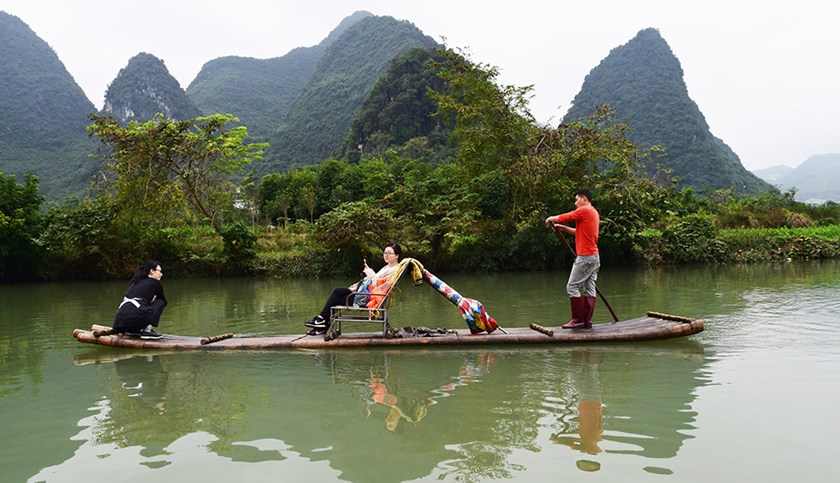
Above: What a great way to spend a lazy day.
The Zhung people, the largest of China’s 55 minority groups, work the fertile land around Yangshuo, which has become known as the country’s Fruit Basket. I see lots of trees flush with tangerines, oranges and other fruits gathered along the shore, as well as clusters of bamboo trees. “That’s where I get my poles,” says Fung, as he warns me that more rapids are quickly approaching.
Fung says the 35 million Zhungs who inhabit this area are a curious lot who like to dine on monkey brains, dog and snake, all of which are readily available at their weekly markets.
The diminutive Zhungs are 2 to 3 centimetres shorter than the average Chinese, but what they lack in height, they more than make up for in strength — they still rely on primitive, back-breaking methods and an odd-looking vehicle called an Iron Buffalo (a cross between a tractor and a truck) to tend their fields.
As we exit the last of the eight rapids, Fung heads for shore. Our 8.2-kilometre journey along the Little Li ends with our skipper pointing us in the direction of downtown Yangshuo.
“Make sure you go to West Street — the food is very good there,” says Fung, as he gets set to welcome more customers.
West Street, which dates back 1,400 years, is Ground Zero in Yangshuo, a city of 600,000, which is relatively small by China standards.
The street is dominated by Western-style bars and restaurants and many of the servers hail from Canada, the U.S. and Australia.
“I came here to climb the mountains and explore the caves and found this place so charming and the people so welcoming that I decided to stay for a while,” says the young Canadian server sporting the Maple Leaf T-shirt in the pizza parlour where we eat lunch.
Signs along West Street are posted in both Chinese and English and many locals speak English, which is uncommon in China.
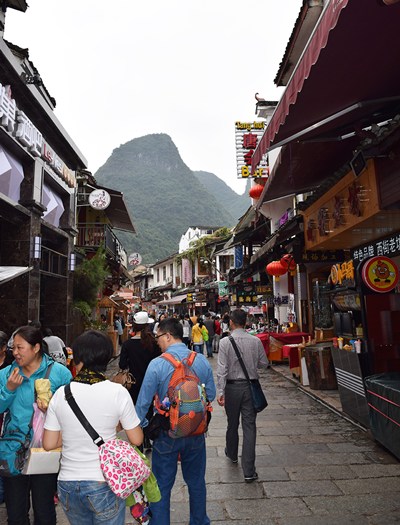

Above: The village is full of tourists and mountain climbers.
There are lots of great climbing spots in Yangshuo, and most are easily accessible by bicycle or public transportation. However, the roads around the city, thanks to the large trucks that haul large rocks from the karst mountains, and the heavy farm equipment used by local farmers, are among the worst this well-seasoned traveller has encountered.
The most famous of the rock climbing mountains is Moon Hill with several 5.13-graded lines. Other crags of note include Low Mountain, Twin Gates, Baby Frog, The Egg, Bamboo Grove and Wine Bottle Cliff.
As we watch the sun set behind the mountains from a West Street restaurant, we realize why Yangshuo is such a hard place to leave.
Information
There are many hotel options in Yangshuo, from hostels to the 5-Star Banyon Tree Resort. For information on the area, go to
www.tourismchina.org / Guilin is accessible from Shenzhen, Hong Kong or Guangzhou by high-speed train. / The best way to get to Yangshuo is via Hong Kong with either Air Canada. / Tour East Holidays (
www.toureast.com) offers tours with stops in Guilin and Yangshuo included.